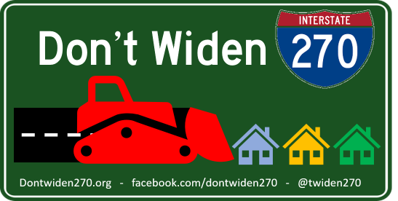The proposal to widen I-270 and I-495 to relieve traffic congestion ignores a fundamental law of traffic: wider roads generate their own traffic. This has been demonstrated repeatedly, around the U.S. and around the world, to such a degree that Maryland's transportation planners should be required to explain why their proposals to widen two of the region's most congested roadways will somehow be exempted from this bedrock principle of traffic.
After all, our transportation planners got a first-hand lesson in this law the last time they widened I-270 to relieve traffic. As the Washington Post reported in 1999, less than eight years after a $200 million project that widened I-270 to up to twelve lanes in some places,
the highway has again been reduced to what one official called "a rolling parking lot." Traffic on some segments already has exceeded the levels projected for 2010.
Robert S. McGarry, Montgomery County's Transportation Director at the time, had pushed hard for the expansion. But he later admitted that "I personally thought [congestion relief] would last much longer than this...I just didn't in my wildest dreams think it would fill up that fast."
Maryland hasn't been alone experiencing this counter-intuitive dynamic, known as "induced demand." In 2008, Texas completed a $2.8 billion project widening I-10 to 23 lanes. Congestion declined for the first few years, but started going up again between 2011 and 2014, according to a study of local traffic data.
California's $1.6 billion expansion of 410 has hardly had any time to relieve congestion - just a year after completion, average commute time is actually slower than it was before the highway was widened.
There's plenty of research indicating the experiences of these states are the rule, not the exception. In 2014, a pair of economists set out to test the idea that more lanes reduce traffic, by comparing highway capacity and vehicle traffic in 228 metro areas around the U.S. As Vox reported,
They found a one-to-one correlation: the more highway capacity a metro area had, the more miles its vehicles traveled on them. A 10 percent increase in capacity, for instance, meant a 10 percent increase in vehicle miles, on average.
When they looked at changes in highway capacity and vehicle miles traveled, they found the same one to one effect. Their findings have been replicated in other countries as well.
A 2015 research report by the National Center for Sustainable Transportation noted that "Numerous studies have examined the effectiveness of this approach and consistently show that adding capacity to roadways fails to alleviate congestion for long because it actually increases vehicle miles traveled (VMT)."
The evidence of our own experience and from around the nation and world make clear that any short-term congestion relief can be expected to be lost within a few years, and traffic will likely get even worse.
The State of Maryland must not be allowed to blind itself to reality, and put the the lives and families and neighborhood communities at risk, in pursuit of what has been clearly shown to be a solution that doesn't work, or that makes the problem worse.
